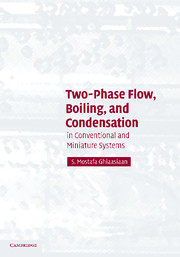Book contents
- Frontmatter
- Contents
- Preface
- Frequently Used Notation
- TWO-PHASE FLOW, BOILING AND CONDENSATION IN CONVENTIONAL AND MINIATURE SYSTEMS
- PART ONE TWO-PHASE FLOW
- 1 Thermodynamic and Single-Phase Flow Fundamentals
- 2 Gas–Liquid Interfacial Phenomena
- 3 Two-Phase Mixtures, Fluid Dispersions, and Liquid Films
- 4 Two-Phase Flow Regimes – I
- 5 Two-Phase Flow Modeling
- 6 The Drift Flux Model and Void–Quality Relations
- 7 Two-Phase Flow Regimes – II
- 8 Pressure Drop in Two-Phase Flow
- 9 Countercurrent Flow Limitation
- 10 Two-Phase Flow in Small Flow Passages
- PART TWO BOILING AND CONDENSATION
- APPENDIX A Thermodynamic Properties of Saturated Water and Steam
- APPENDIX B Transport Properties of Saturated Water and Steam
- APPENDIX C Thermodynamic Properties of Saturated Liquid and Vapor for Selected Refrigerants
- APPENDIX D Properties of Selected Ideal Gases at 1 Atmosphere
- APPENDIX E Binary Diffusion Coefficients of Selected Gases in Air at 1 Atmosphere
- APPENDIX F Henry's Constant of Dilute Aqueous Solutions of Selected Substances at Moderate Pressures
- APPENDIX G Diffusion Coefficients of Selected Substances in Water at Infinite Dilution at 25°C
- APPENDIX H Lennard–Jones Potential Model Constants for Selected Molecules
- APPENDIX I Collision Integrates for the Lennard–Jones Potential Model
- APPENDIX J Physical Constants
- APPENDIX K Unit Conversions
- References
- Index
10 - Two-Phase Flow in Small Flow Passages
- Frontmatter
- Contents
- Preface
- Frequently Used Notation
- TWO-PHASE FLOW, BOILING AND CONDENSATION IN CONVENTIONAL AND MINIATURE SYSTEMS
- PART ONE TWO-PHASE FLOW
- 1 Thermodynamic and Single-Phase Flow Fundamentals
- 2 Gas–Liquid Interfacial Phenomena
- 3 Two-Phase Mixtures, Fluid Dispersions, and Liquid Films
- 4 Two-Phase Flow Regimes – I
- 5 Two-Phase Flow Modeling
- 6 The Drift Flux Model and Void–Quality Relations
- 7 Two-Phase Flow Regimes – II
- 8 Pressure Drop in Two-Phase Flow
- 9 Countercurrent Flow Limitation
- 10 Two-Phase Flow in Small Flow Passages
- PART TWO BOILING AND CONDENSATION
- APPENDIX A Thermodynamic Properties of Saturated Water and Steam
- APPENDIX B Transport Properties of Saturated Water and Steam
- APPENDIX C Thermodynamic Properties of Saturated Liquid and Vapor for Selected Refrigerants
- APPENDIX D Properties of Selected Ideal Gases at 1 Atmosphere
- APPENDIX E Binary Diffusion Coefficients of Selected Gases in Air at 1 Atmosphere
- APPENDIX F Henry's Constant of Dilute Aqueous Solutions of Selected Substances at Moderate Pressures
- APPENDIX G Diffusion Coefficients of Selected Substances in Water at Infinite Dilution at 25°C
- APPENDIX H Lennard–Jones Potential Model Constants for Selected Molecules
- APPENDIX I Collision Integrates for the Lennard–Jones Potential Model
- APPENDIX J Physical Constants
- APPENDIX K Unit Conversions
- References
- Index
Summary
The scale effect in two-phase flow and the classification of channel sizes were discussed in Section 3.6.2. The discussions in this chapter will primarily deal with channels with hydraulic diameters in the range 10 μm ≲ DH ≲ 1mm, where the limits are understood to be approximate magnitudes. For convenience, however, channels with 10 μm ≲ DH 100 < μm will be referred to as microchannels, and channels with 100 μm ≲ DH ≲ 1mm will be referred to as minichannels. The two categories of channels will be discussed separately, furthermore, because as will be seen there are significant differences between them.
Single-phase and two-phase flows in minichannels have been of interest for decades. The occurrence of flashing two-phase flow in refrigerant restrictors formed the impetus for some of the early studies (Mikol, 1963; Marcy, 1949; Bolstad and Jordan, 1948; Hopkins, 1950). The number of investigations dealing with two-phase flow in minichannels is relatively large, but two-phase flow in microchannels is a more recent subject of interest.
Two-phase flow in mini- and microchannels comprises a dynamic and rapidly developing area. Some attributes of two-phase flow in mini- and microchannels are not fully understood, and there are inconsistencies among experimental observations, phenomenological interpretation, and theoretical models. This chapter is therefore meant to be an outline review of the current state of knowledge.
Two-Phase Flow Regimes in Minichannels
Two-phase flow regimes in minichannels under conditions where inertia is significant have been experimentally investigated rather extensively. Table 10.1 summarizes some of the published studies.
- Type
- Chapter
- Information
- Two-Phase Flow, Boiling, and CondensationIn Conventional and Miniature Systems, pp. 245 - 284Publisher: Cambridge University PressPrint publication year: 2007



